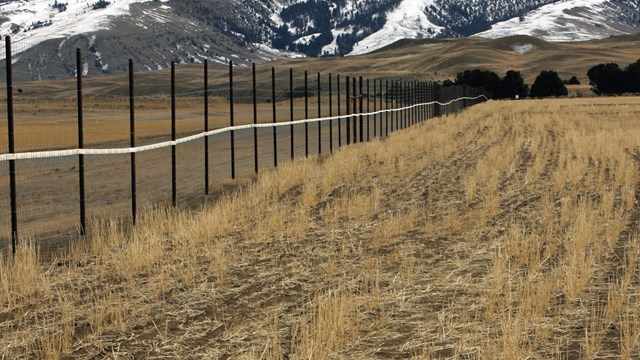
NPS/Pat Perrotti Invasive nonnative plants can displace native plant species, including some endemic to the park’s geothermal habitats, change the nature of vegetation communities and affect fire frequency and the distribution, foraging activity, and abundance of wildlife. These changes can profoundly affect the entire ecosystem. For example, nonnatives that are unpalatable to wildlife may replace preferred native plants, leading to changes in grazing activity. In turn, this stresses plants not adapted to grazing. Invasive plants have altered views of the park’s cultural landscapes and historic districts. Seeds may be spread by people and their vehicles, wild and domestic animals, and sand and gravel used for construction and maintenance work. The most vulnerable areas have been disturbed by human use: along the roads, trails, and rivers— though they are spreading from developed areas to the backcountry. Restoring native plants in an area that has become infested is extremely difficult. In addition to about 1,386 native plant species, 225 nonnative species have been documented in the park through ongoing survey efforts. Not all of these nonnative species are still present in the park, but most of them are. 
NPS Managing Invasive PlantsControlling all the invasive plants—some well-established— is unrealistic. Staff prioritize treatments based on the threat they pose to native plant communities and the likelihood for successful control. Some infestations can be eradicated if the species is treated when the outbreak is still small; other species, such as spotted knapweed (Centaurea maculosa), are so common that stopping them from spreading is the primary goal. This strategy has helped prevent high priority invasive species from moving into wilderness areas where control is more difficult. Nonnative vegetation was found on 7,189 acres of the 7,914 acres inventoried in 2015. Sometimes exotic plants are found in pure populations with few native plants, but are most often mixed within native plant communities. Based on program priorities for species, the equivalent of 120 acres of pure nonnative populations was treated during 2015. Physical removal is the preferred method of control when feasible, but pulling or cutting of some of the perennial species serves to stimulate new growth, and the use of herbicides becomes necessary to control aggressive species over large areas. Plants were physically pulled or clipped on 20 acres while the remaining 100 acres were treated with herbicides. Most of the 36 species targeted for treatment are listed by the states of Idaho, Montana, or Wyoming as “noxious weeds,” which means they are detrimental to agriculture, fish and wildlife, aquatic navigation, or public health. Preventing the Spread of Invasive PlantsPrevention efforts include control of construction materials entering the park, equipment inspections at park entrances, allowing only certified weed-free hay to be transported through the park, restrictions on the use of hay in the backcountry, and planting native species where ground disturbance has occurred. To improve nonnative plant management throughout the region, park staff work with land managers from other government agencies, the Greater Yellowstone Coordinating Committee’s Weed Subcommittee, and the National Park Service’s Rocky Mountain Exotic Plant Management Team. The park uses Integrated Pest Management— chemical, biological, sociological, and mechanical methods—to control some of the nonnative plants. The park also cooperates with adjacent state and county Weed Control Boards to share knowledge and technology related to nonnative plant detection and control. Source: NPS DataStore Collection 7871. To search for additional information, visit the NPS DataStore. 
Restoring Native Plants
Park managers are restoring native vegetation to this area, following recommendations of arid land restoration specialists. 
Vegetation & Resources Management Branch
Park employees inventory, monitor, manage, and research the vast array of plant communities in the park. 
Plants
Spring is a time for plant growth, fueling the return of many migratory species. |
Last updated: April 18, 2025
